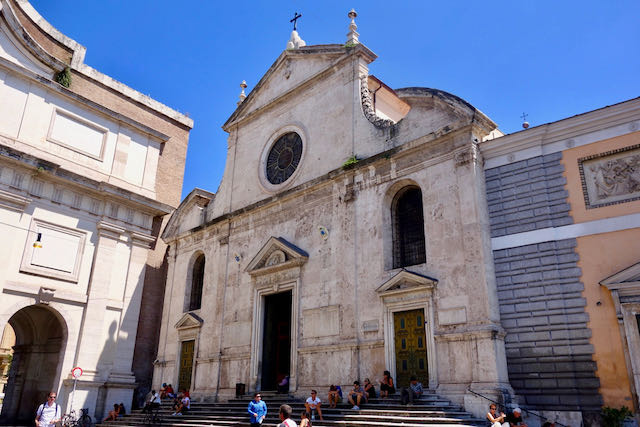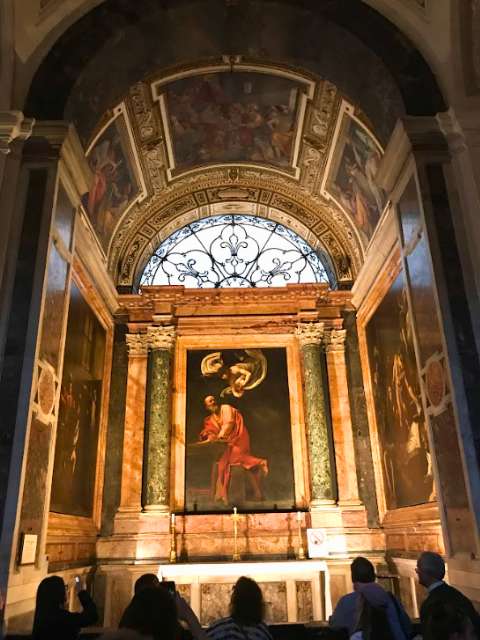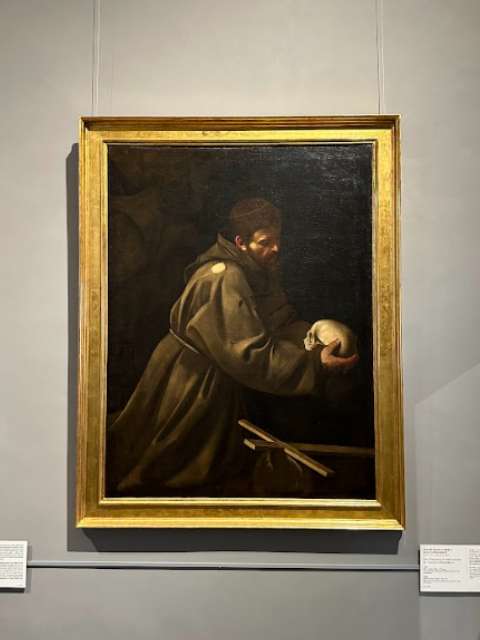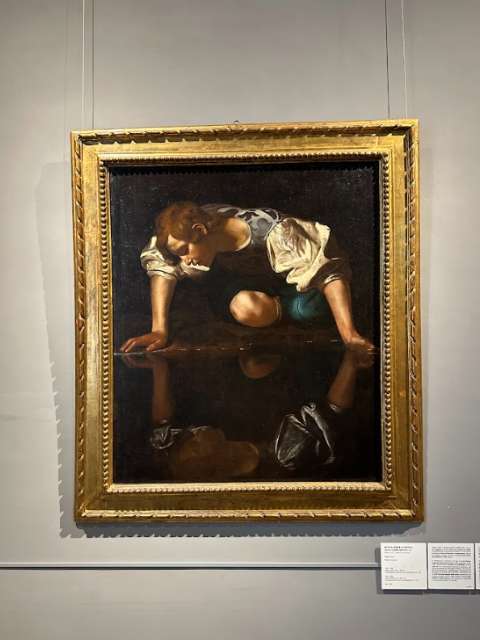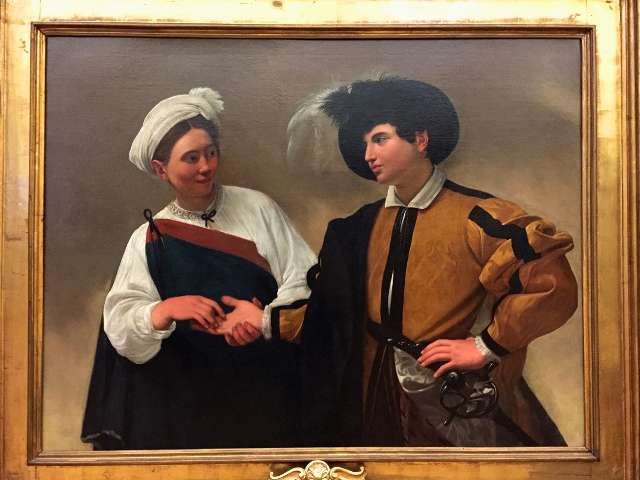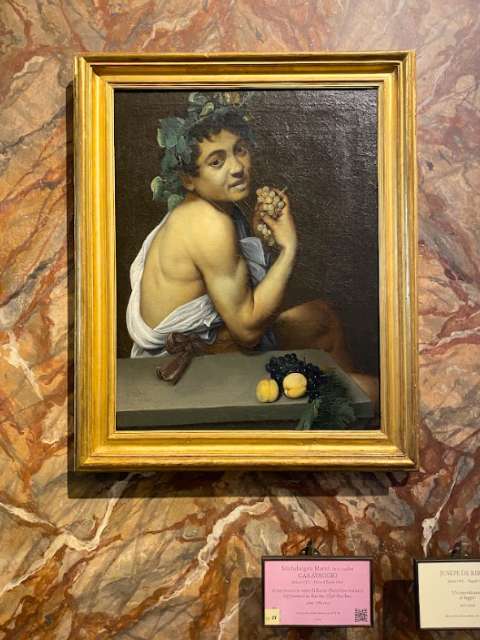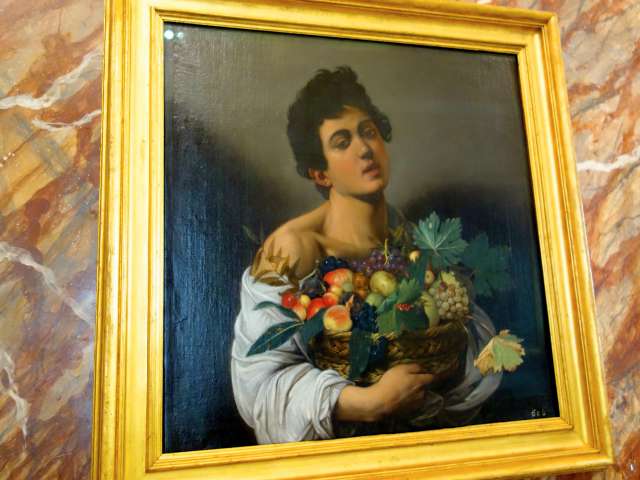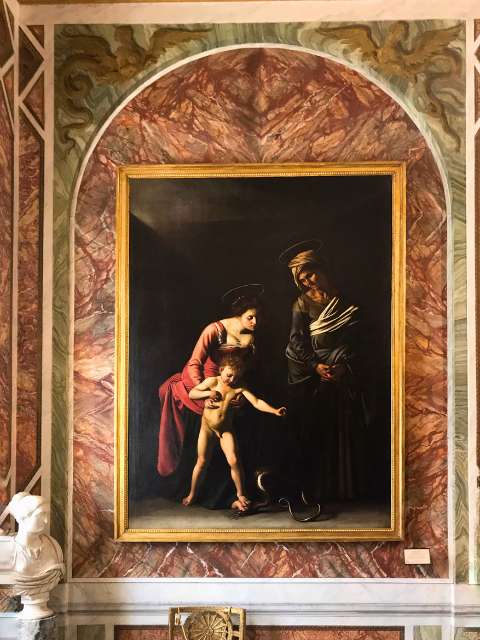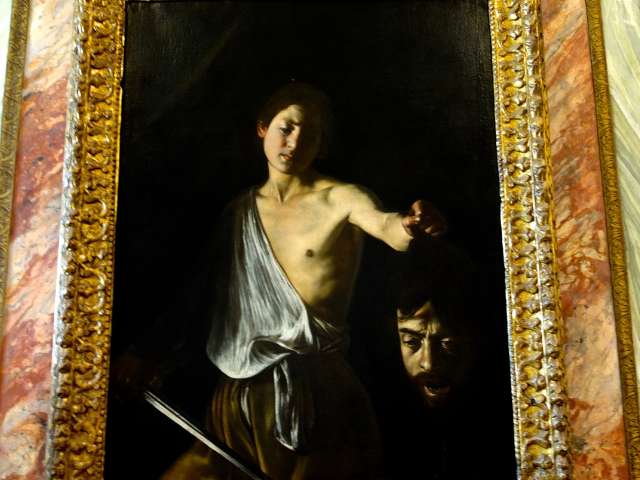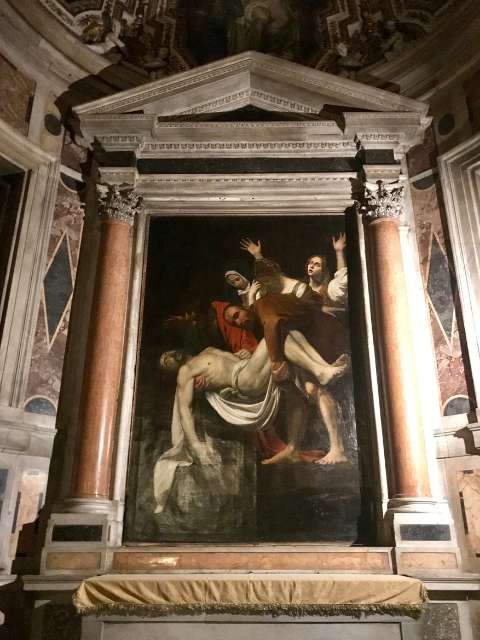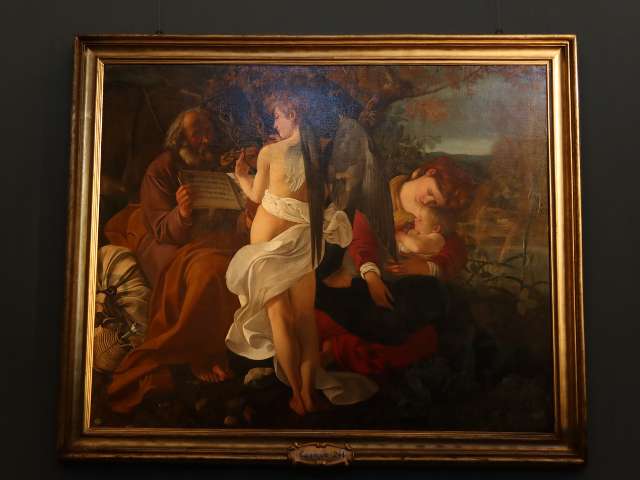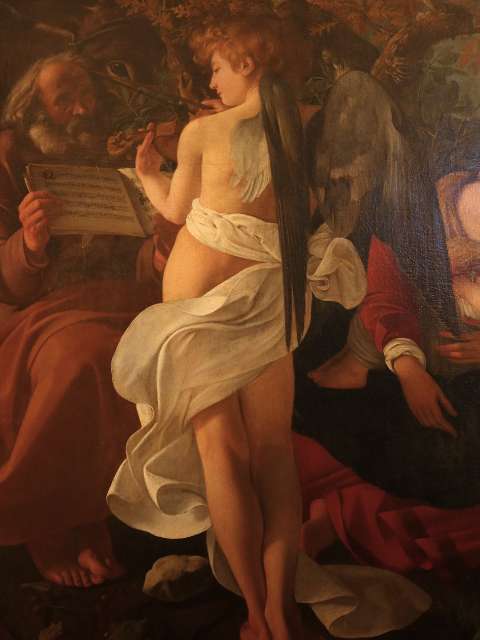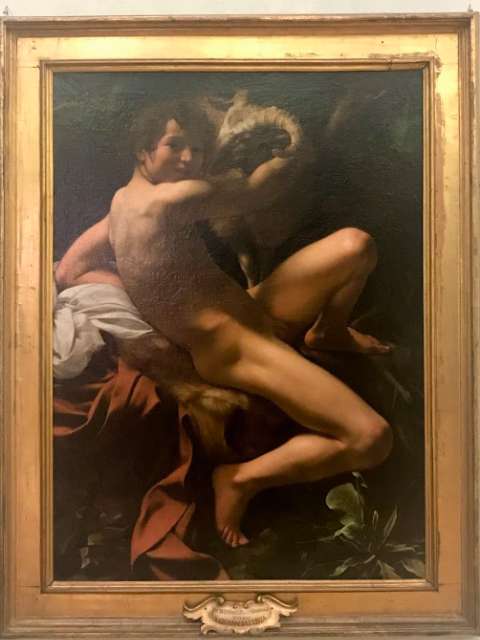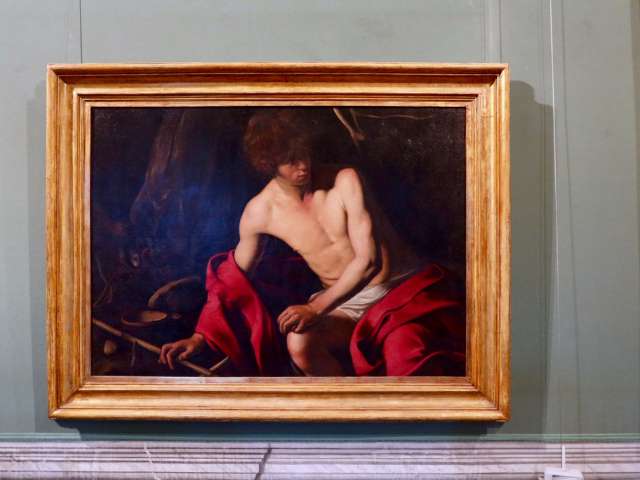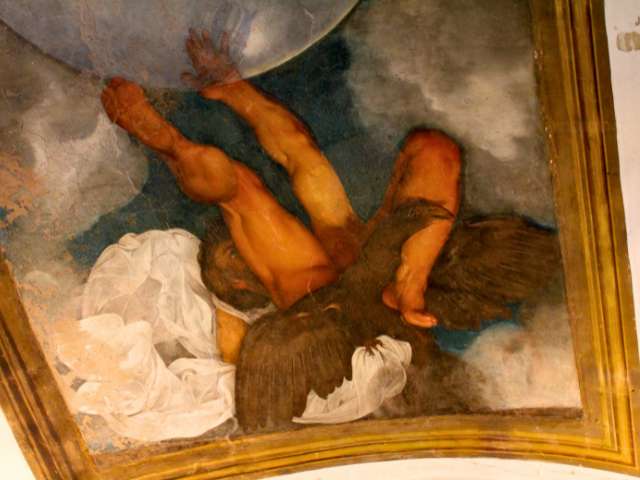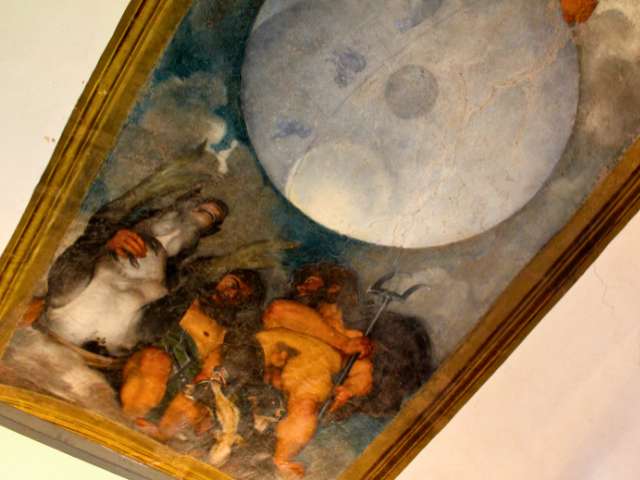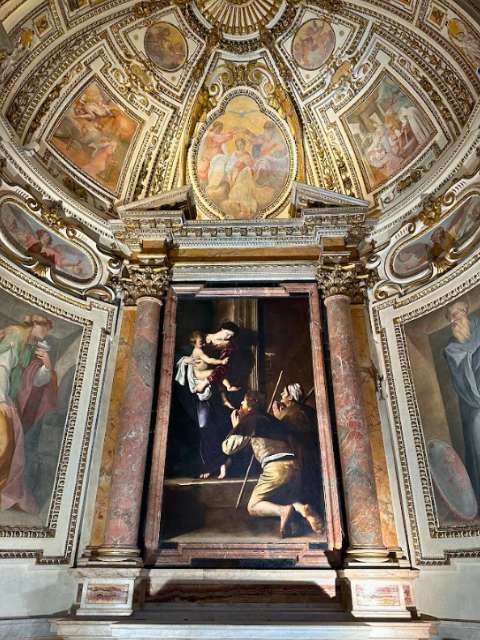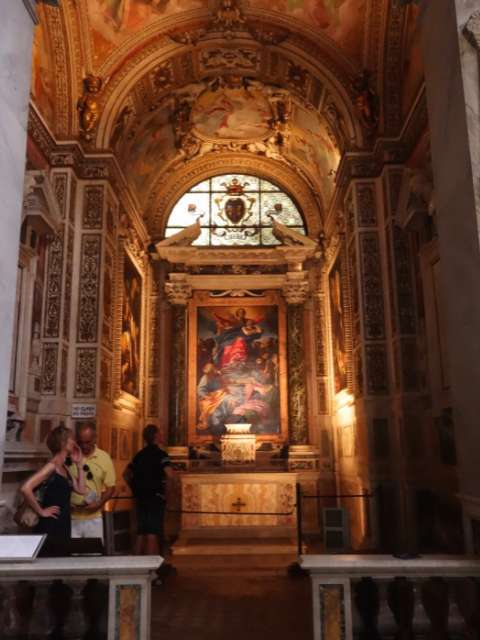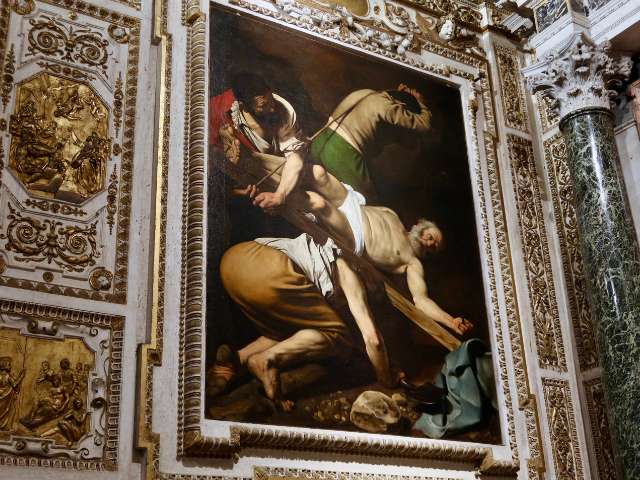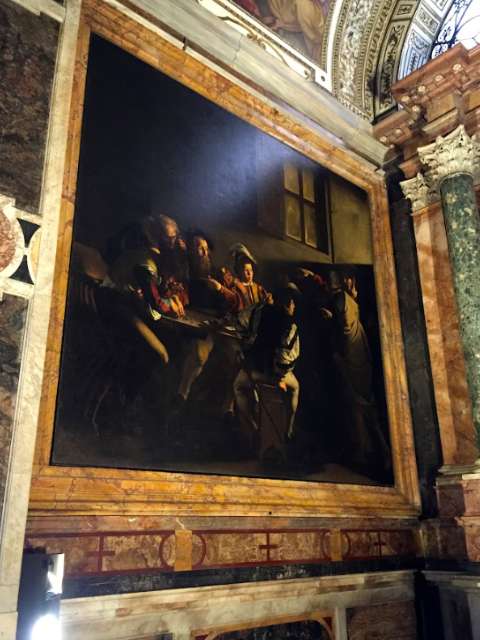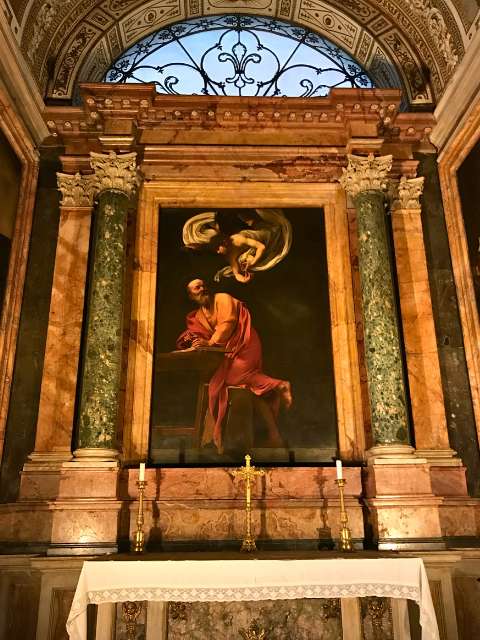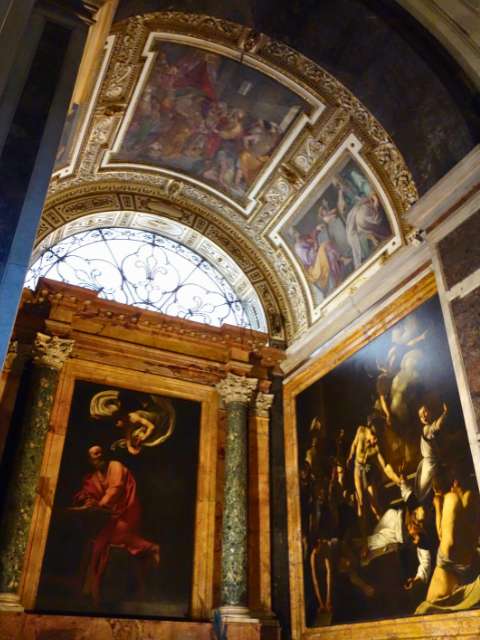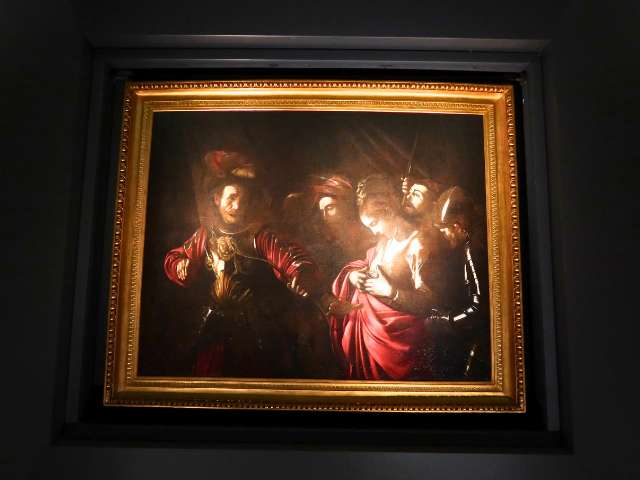- Sign up & get a FREE ebook Subscribe NOW!
- Romewise Home Page
- What to Do in Rome
- caravaggio paintings in rome
Caravaggio Paintings in Rome: Your complete guide
Wondering where to find Caravaggio paintings in Rome?
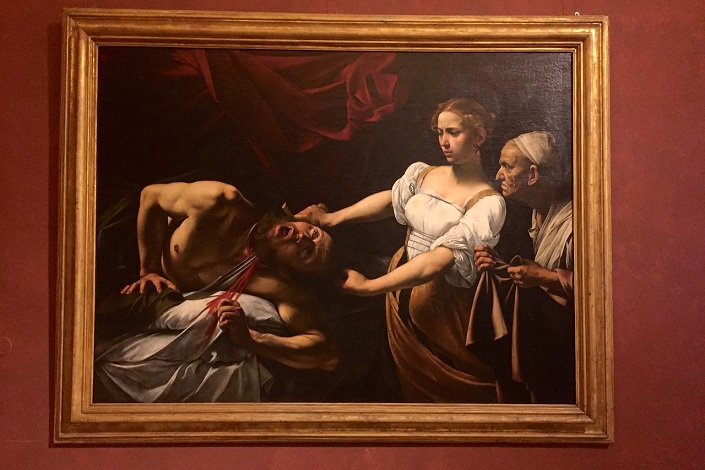 The painting of 'Judith Beheading Holofernes' is one of Caravaggio's most famous pieces, but where is this found in Rome? Keep reading to find out!
The painting of 'Judith Beheading Holofernes' is one of Caravaggio's most famous pieces, but where is this found in Rome? Keep reading to find out!Read on for our complete guide to Caravaggio's works in the Eternal City!
Discovering the Caravaggio paintings in Rome - Everything you need to know
One of my favorite things about living in Rome is how much stunning art and architecture you can see by just walking around the city and popping into churches.
In Rome, not only do we have three churches but also museums and palazzos where you can see many masterpieces by one of the world's most celebrated artists, Michelangelo Merisi da Caravaggio, known as just "Caravaggio."
Who was he? Why did he die so young?
And what was his effect on Baroque painting?
Read on to find out where you can find Caravaggio in Rome!
On this page, we'll cover:
- Some interesting facts about Caravaggio's life
- How did Caravaggio die?
- Where can you find Caravaggio works in Rome?
- Where can you see Caravaggio in Rome for free?
- Is Caravaggio's art Renaissance or Baroque?
- Where else in Italy can you see Caravaggio paintings?
Interesting facts about Caravaggio's life
Caravaggio's early life
Michelangelo Merisi da Caravaggio was born in 1571 in a small town of that name in Lombardy, Northern Italy.
Some sources have him as being born in Milan instead.
His father was a stonemason, but although he was from a simple background, Caravaggio's mother had connections with the local nobility, particularly the influential and powerful Sforza and Colonna families.
This link to power would prove enough to open doors for Caravaggio as he got older.
At just thirteen years old he became a painter's apprentice in Milan, but had to leave the city in 1592 because he had got himself in trouble with the law.
This pattern would be repeated many times over his lifetime!
✨ Experience all of Rome's Magic in a Day ✨
Wander through the city's historic center with a local guide, discovering iconic landmarks like the Trevi Fountain, Pantheon, and Piazza Navona — then take a private transfer to The Vatican. Perfect for first-time or hundreth-time visitors, this expertly guided tour reveals the Eternal City’s beauty and rich history at its most enchanting.
Caravaggio in Rome
Caravaggio arrived in Rome with very little to his name, and few connections.
However, very quickly his innate talent attracted attention, although his naturalist style choice was not popular at the time and some commissions were rejected.
In 1599 he was selected to decorate the Contarelli chapel in the church of San Luigi dei Francesi (located in between Piazza Navona and the Pantheon), and when his paintings were unveiled in 1600 they caused a sensation.
From this point on he was very much in demand, producing his most famous works for patrons all over Rome.
Why did Caravaggio leave Rome?
When in Rome Caravaggio had a reputation as a violent and difficult-to-handle individual, even at a time when violence was common.
He was often involved in bar brawls, challenged adversaries to duels, and in 1606 had a sword fight with Rannucio Tomassoni who died from his injuries.
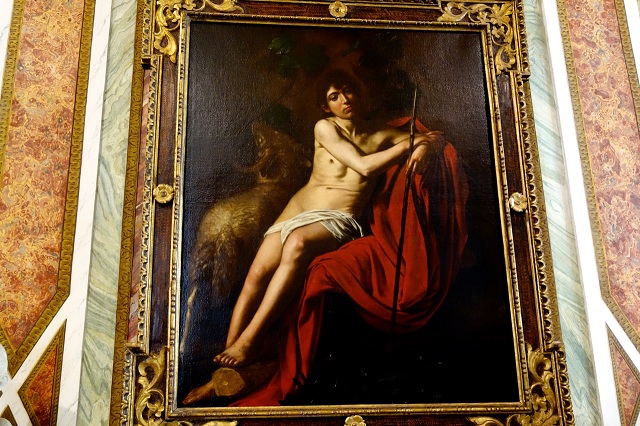 Caravaggio's portrayal of John the Baptist (this version is in the Galleria Borghese today) is one of his last works, painted while he was in Naples
Caravaggio's portrayal of John the Baptist (this version is in the Galleria Borghese today) is one of his last works, painted while he was in NaplesWanted for murder, Caravaggio fled Rome, going first to Naples and then to Malta, where he joined the military and religious order, the Knights of Malta.
True to form, he fought with another member of the order and was expelled.
Caravaggio then moved on to Sicily before returning to Naples, where he lived for some time.
While in Naples, he was involved in yet another street brawl and was injured badly.
He got on a ship headed for Rome, hoping to gain a papal pardon, but sadly he died before he could attempt this.
Why is Caravaggio so famous?
Caravaggio's paintings are particularly known for their unique style.
He painted using a special technique known as chiaroscuro, a treatment of light and shade which uses contrast to highlight specific details.
He also chose to portray subjects in extreme realism, which was in direct contrast to the Renaissance style of artists like Michelangelo and Raphael.
This was very unusual at the time, and caused Caravaggio to stand out.
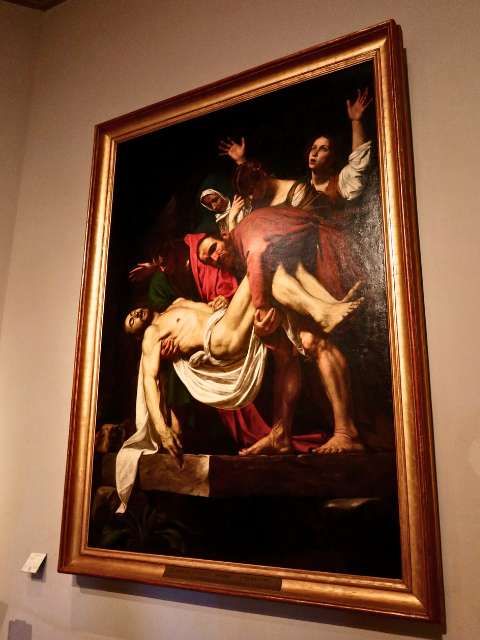 Images like this one, the 'Deposizione' demonstrate the painting style Caravaggio was equally praised and criticised for
Images like this one, the 'Deposizione' demonstrate the painting style Caravaggio was equally praised and criticised forHe also tended to paint straight on to the canvas with no preparation, and favored a subject matter of ordinary people with few embellishments.
He was subject to significant criticism from some quarters during his lifetime because of his unusual choices, but others could see his genius.
His work came to be universally admired and hugely influential on future artists.
How did Caravaggio die?
Caravaggio died in 1610, and while we know roughly where and when, the cause of his death is the subject of much debate.
The ship that was to take him to Rome reached its destination, but there is no record of him in the Eternal City.
The most generally accepted location of Caravaggio's death is the small coastal town of Porto Ercole in Tuscany, but it has also been suggested that he died in the Lazio countryside near Rome.
As for how he died, many sources claim that Caravaggio succumbed to malaria.
This is disputed by some historians who suggest he may have died from syphilis.
At the time of his death, rumors circulated that he had been killed, either by the Knights of Malta or a family of an adversary in Sicily.
Others claim he had died from sepsis due to being stabbed in a sword fight just before leaving for Rome.
Another possible cause of his death was lead poisoning.
This is a strong possibility as paints of the time were lead-based, and Caravaggio was known to be liberal with his paints.
However, the possible events surrounding Caravaggio's death took a strange turn in 2002, when the Vatican released documents claiming that the Tomassini family had killed Caravaggio as revenge for the murder of Rannucio Tomassini.
As with all claims to his death, the document is hotly disputed.
While we will likely never know the cause of Caravaggio's death for certain, it's fitting that such an enigmatic figure should meet such a mysterious end!
Where can you find Caravaggio paintings in Rome?
Luckily for us, you can visit many Caravaggio masterpieces in Rome.
Caravaggio's works are free to visit at three churches in Rome, the Basilica di Sant'Agostino, the Church of Santa Maria del Popolo and San Luigi dei Francesi.
More of Caravaggio's works can be found at the Galleria Nazionale d'Arte Antica at Palazzo Barberini, the Capitoline Museums, Galleria Borghese, Vatican Museums, Galleria Doria Pamphilj, Palazzo Corsini, and Casino di Villa Boncompagni Ludovisi.
Keep reading for our complete breakdown of where to go and which of Caravaggio's works you can see in Rome:
Santa Maria della Concezione dei Cappuccini
Saint Francis in Prayer, 1610
There are two versions of St Francis in Prayer.
There is this one in Santa Maria della Concezione dei Cappuccino and another found in the Carpineto Romano.
The differences are in the layout and presentation, each featuring a slightly different pose and head position.
There have been disputes about whether they are both by the artist, but art historians are confident they are from the hand of Caravaggio.
Galleria Nazionale d'Arte Antica at Palazzo Barberini
Judith Beheading Holofernes, c. 1598
Judith Beheading Holofernes is one of the most famous paintings by Caravaggio.
The painting depicts the moment of the assassination of Holofernes, a Syrian General who was sent to destroy the city of Bethulia.
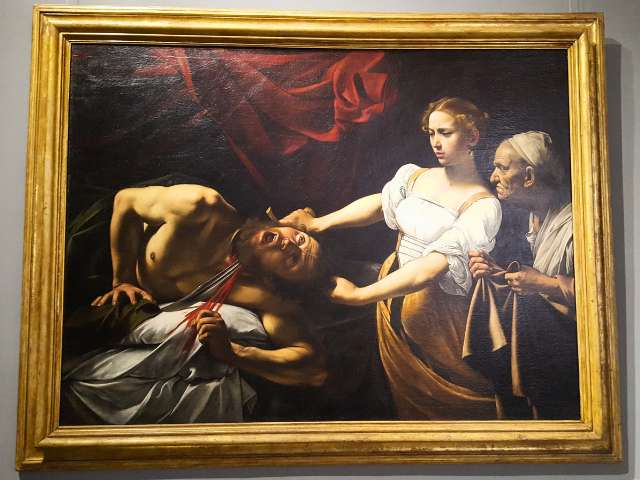 The intense realism of 'Judith Beheading Holofernes' stops you in your tracks, even more so seeing it in person!
The intense realism of 'Judith Beheading Holofernes' stops you in your tracks, even more so seeing it in person!Judith, a pious young widow moved by the plight of her people goes to the general's tent on the pretext of bringing information.
He is charmed by her beauty and asks her to dine with him.
Holofernes gets drunk, Judith seizes a sword and slays him and saves her city.
The model for Judith is probably the Roman courtesan Fillide Melandroni, who posed for several other works by Caravaggio in 1598.
Narcissus, c. 1599
This painting is one of only two known Caravaggio's with a theme from classical mythology.
Caravaggio paints the handsome youth Narcissus who falls in love with his own reflection.
Unable to tear himself away, he dies and as he crosses the river Styx, he continues to gaze at his reflection.
Capitoline Museums
Fortune Teller, c. 1594
The Fortune Teller is typical of Caravaggio's works, which often painted ordinary people.
He painted two versions of the scene, this one is in the Capitoline Museums and the other, a slightly later version, is in the Louvre in Paris.
The version in Rome shows a young man whose manner of dressing puts him in the upper classes of Roman society.
Holding his hand is a Romanian girl, the Fortune Teller of the title.
She holds his hand underneath, palm up, stroking his palm while looking straight at him.
The boy does not realize she is removing a ring from his finger!
The date for the painting is disputed but is thought to be around 1594.
John the Baptist, 1602
This unusual composition depicting a young naked St John the Baptist or San Giovanni Battista.
Unusually, the Baptist is without the items he is usually identified by; a bowl, a reed cross, and a lamb, which has raised discussions about the accuracy of the subject.
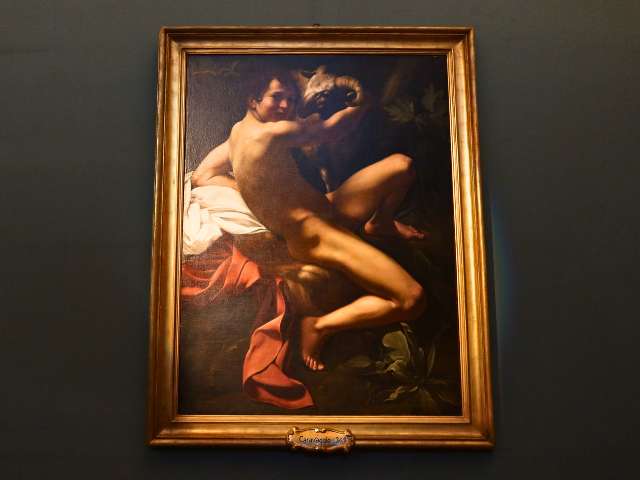 Of the many depictions of St John the Baptist that Caravaggio created, this one is of particular interest
Of the many depictions of St John the Baptist that Caravaggio created, this one is of particular interestDated to 1602-03, this wonderful masterpiece is a remarkable example of a portrait of Saint John that removes the religious connotations.
It was intended for private ownership rather than to display openly in a church or place of worship.
Borghese Gallery
The world-famous Borghese Gallery houses a fabulous collection of quality artworks, including several famous paintings by Caravaggio.
The Borghese Gallery was once the home of the Borghese family, and the collection was put together originally by Cardinal Scipione Borghese, who had an eye for art.
Along with the Caravaggios, the Galleria Borghese also features significant works by the painter Titian and sculptures by one of the finest of all, Gian Lorenzo Bernini.
Young Sick Bacchus, c. 1593
Young Sick Bacchus depicts an unwell Bacchus with grapes and is painted against a dark background.
It is considered a still life, and yet historians believe it was a self portrait created using a mirror.
The self portrait was likely used by Caravaggio to market himself, demonstrating his capability in painting still life and portraits.
Boy with a Basket of Fruit, c. 1593
Formerly in the collection of Guiseppe Cesari, this painting is another early example of Caravaggio's work in still life.
The model in the picture is Mario Minniti, about 16 years old, and a friend and companion of Caravaggio in Rome.
In this composition, Minniti holds an intricate bowl of fruit and stands in a slightly awkward pose, looking out at the viewer with his head tilted.
It is a very realistic work for the artist, and the fruit is highly detailed.
Saint Jerome Writing, 1605-6
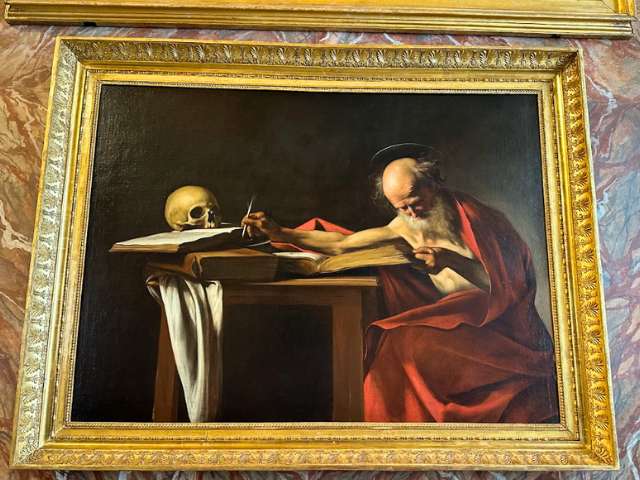 This painting has always been particularly appealing to me, something about the reality of the saint reading his books intently really resonates with me!
This painting has always been particularly appealing to me, something about the reality of the saint reading his books intently really resonates with me!This painting of Saint Jerome reading intently, an outstretched arm resting with quill was created for Cardinal Scipione Borghese.
It is believed to have been done during Caravaggio's late Roman period.
Madonna and Child with St. Anne (Dei Palafrenieri), 1606
Madonna and Child with St Anne is a Caravaggio with an interesting back story.
The painting shows the Virgin leaning forward, holding the Christ child, with Saint Anne looking on.
On the floor is a snake, the 'serpent of heresy', an ancient myth that appears in biblical writings.
The painting was initially installed on an altar in St Peter's Basilica but was removed after a few days as the Virgin is considered to be showing too much bosom, and the snake was too realistic.
This would not be the only time the artist painted a Madonna thought to be indecent!
John the Baptist, 1610
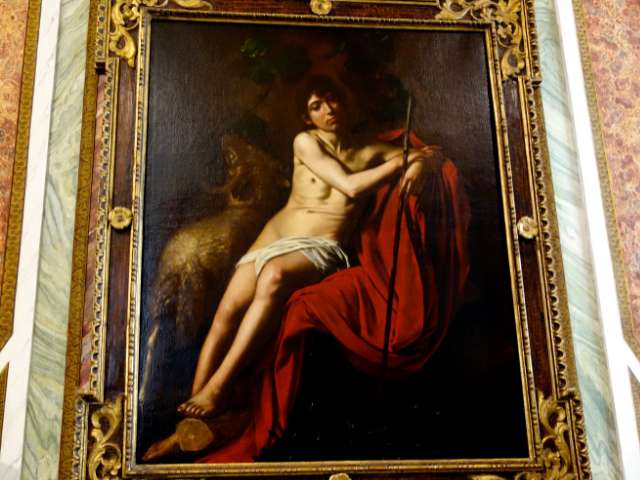 Showing saints as children was unusual at the time, so Caravaggio's version here drew attention immediately
Showing saints as children was unusual at the time, so Caravaggio's version here drew attention immediatelyCaravaggio is known to have painted at least eight images of John the Baptist, and the one in the Galleria Borghese is of particular interest.
Unusually, it depicts him as a playful child, with a sheep in the composition.
The date of this San Giovanni Battista painting is disputed, yet art historians have claimed that it is from the artist's time in Sicily, judging by the use of light and color.
David with the Head of Goliath, 1610
Caravaggio's painting, David with the Head of Goliath, is interesting for a few reasons.
First, it is undoubtedly one of his most famous works, explicitly depicting the famous biblical legend.
What is more interesting to art historians is that the head of Goliath is a Caravaggio self-portrait.
The painting is believed to have been a personal gift from the artist to Cardinal Borghese, who held great status within the papacy.
It is thought to have been intended as a plea for clemency while Caravaggio was wanted for murder.
Vatican Museums, Pinacoteca
Deposizione (The Entombment of Christ) 1603
The Deposizione is one of Caravaggio's most admired altarpieces.
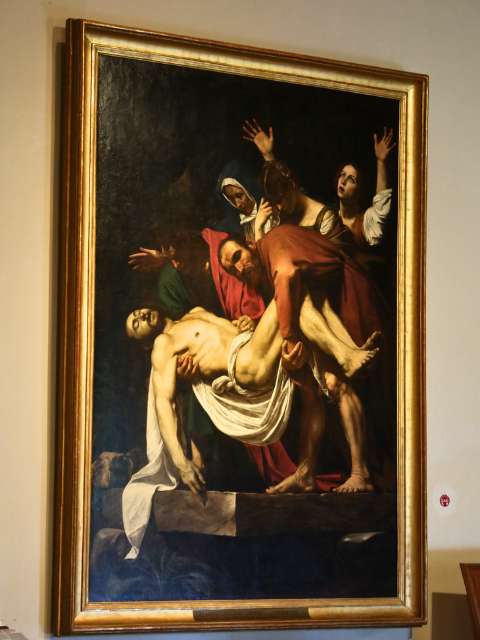 This Caravaggio was only returned to Rome in the 1800's, it was so appealing to Napoleon that he took it back to Paris with him
This Caravaggio was only returned to Rome in the 1800's, it was so appealing to Napoleon that he took it back to Paris with himCaravaggio was commissioned to paint The Entombment Of Christ for the church of Santa Maria in Vallicella.
The dead Christ is being moved to his tomb by Nicodemus and John.
Close to him are Mary, Mary Magdalene, and Mary of Cleophas who is raising her arms and eyes towards heaven in prayer.
The painting was removed by Napoleon and taken to Paris in 1797, it was not returned to Rome until 1816 when it was installed in the Vatican Museums.
A copy of the painting is now in the chapel in Santa Maria in Vallicella, with the original in the Pinacoteca in the Vatican Museums.
✨ Roman Luxury and Charm ✨
Discover a cocktail of Roman luxury and architectural beauty with these tours to Rome's historic palazzo Doria Pamphilj.
Galleria Doria Pamphilj
The Galleria Doria Pamphilj is a lesser known museum in Rome, but is well worth a visit if you're an art lover.
Penitent Magdalene, c. 1597
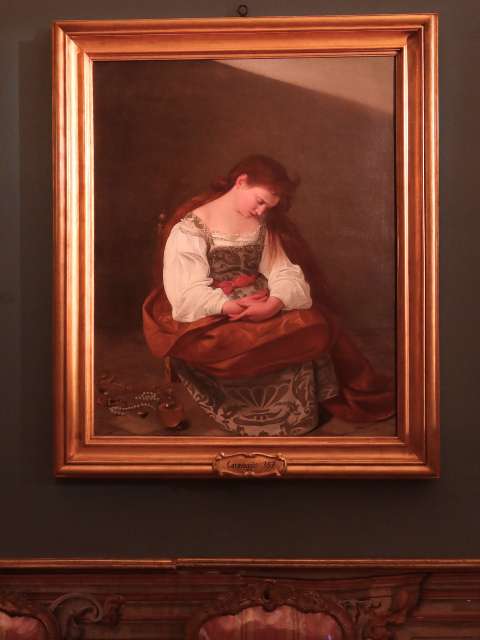 The simple pose of the Penitent Magdalene invites you in to take a closer look
The simple pose of the Penitent Magdalene invites you in to take a closer lookPenitent Magdalene depicts Mary Magdalene in a repentant and spiritual transformation.
Mary Magdalene's expression convey her repentance and devotion.
The portrayal of human emotion make it a timeless masterpiece, capturing the themes of redemption and forgiveness.
Rest on the Flight into Egypt, c. 1597
Rest on the Flight into Egypt captures a moment of rest during the Holy Family's escape to Egypt.
The painting portrays The Virgin Mary and the infant Jesus sleeping under a tree, while Joseph holds a manuscript for an angel who plays a hymn on a violin.
John the Baptist, c. 1602
John the Baptist is depicted as a young, contemplative figure, illuminated by a soft light that accentuates his introspective gaze.
The youthful San Giovanni Battista is shown half-reclining, one arm around a ram's neck, his face turned to the viewer with an impish grin.
Palazzo Corsini
John the Baptist, c. 1604
Yet another painting of Saint John, this is one of two John the Baptists painted by Caravaggio in or around 1604.
The figure has been stripped of identifying symbols with no belt, and the reed cross is only suggested.
This version of John the Baptist introduces him with more realism and drama.
Casino di Villa Boncompagni Ludovisi
Jupiter, Neptune and Pluto, 1597
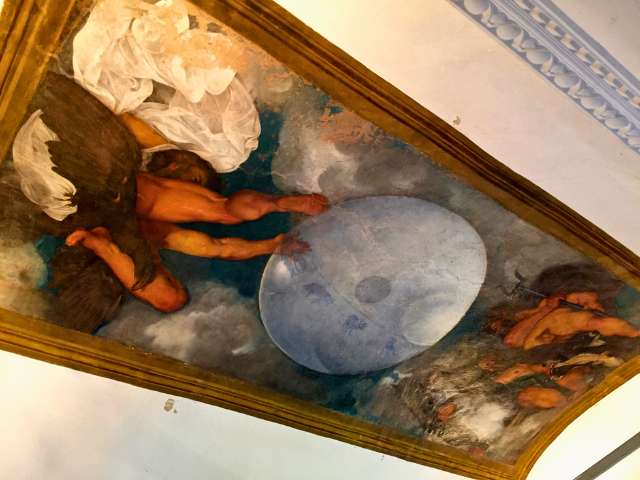 Sadly this unique ceiling painting may be lost to the public if the inheritance dispute does not get resolved
Sadly this unique ceiling painting may be lost to the public if the inheritance dispute does not get resolvedThe only known Caravaggio oil painting on a ceiling, this dramatic rendition of three gods from ancient art was painted for the artist's patron Cardinal del Monte.
The villa is now a private house, and there is considerable interest in this artwork as it is within a building that currently stands empty.
A famous recent incident saw the inhabitant, Princess Rita Ludovisi, the widow of Prince Nicolo Boncompagni, evicted from the villa following an inheritance dispute with her husband's children.
Italian authorities ruled the house must be sold to solve the dispute.
The authorities have put the house up for auction four times, and there were no bidders.
The fate of the famous and unique Caravaggio and many other precious artworks, including a statue of Pan by Michelangelo is currently unknown.
Ready to plan your trip?
Book your train
Planning to travel between cities in Italy and other parts of Europe?
Use Trainline to see all the different options available across the different rail companies.
Find your hotel
Find your perfect place to stay in Rome.
Use Booking.com to choose between hotels, guesthouses, and self-catering apartments in neighborhoods throughout the Eternal City.
Buy your TurboPass
Purchase the convenient Turbopass and visit all of Rome's top attractions including the Colosseum, Pantheon, and Vatican.
With one handy pass, it's all included.
Where can you see Caravaggio in Rome for free?
In all these churches listed here, Caravaggio's masterpieces are in chapels that are best seen when lit.
So while it's free to enter the churches, you may wish to spend the 1-2 Euros required to light up the chapel.
While you can see these Caravaggio works by yourself, for free, you can also take a tour with a dedicated guide to learn more about the different pieces.
This art-themed walking tour is a great way to explore some of Rome's most amazing churches!
Basilica di Sant'Agostino (near Piazza Navona)
Madonna of Loreto, c. 1604
Caravaggio painted the Virgin Mary holding her child and two pilgrims kneeling at her feet.
The painting caused an uproar upon its unveiling, as it depicts the Virgin Mary as an ordinary woman with only a slight halo highlighting her saintliness.
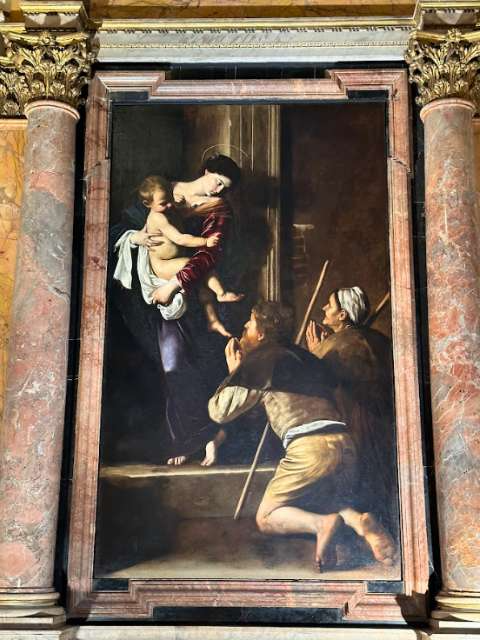 While this may not seem shocking to a modern audience, this portrayal of the Madonna was very controversial!
While this may not seem shocking to a modern audience, this portrayal of the Madonna was very controversial!She is barefoot, as are the pilgrims in the painting, and the background is a simple setting.
Such a composition came as a shock to those used to traditional religious paintings.
Church of Santa Maria del Popolo (in Piazza del Popolo)
There are two Caravaggio paintings in the lovely church of Santa Maria del Popolo, both in the Cerasi Chapel:
Crucifixion of Saint Peter, 1601, Cerasi Chapel
The Crucifixion of Saint Peter is a dramatic and highly detailed painting.
It depicts the famous tale of St Peter asking to be crucified upside down as he didn't believe he was worthy of death in the same manner as Jesus Christ.
Conversion of Saint Paul on the Road to Damascus, 1601, Cerasi Chapel
Also in the Cerasi Chapel in Santa Maria del Popolo, The Conversion of Saint Paul or Conversione di San Paolos tells a well-known biblical story.
According to the New Testament, Saul of Tarsus went from Jerusalem to Damascus to arrest Christians but witnesses a 'divine light' and hears the voice of Jesus, causing him to convert and take the name of Paul.
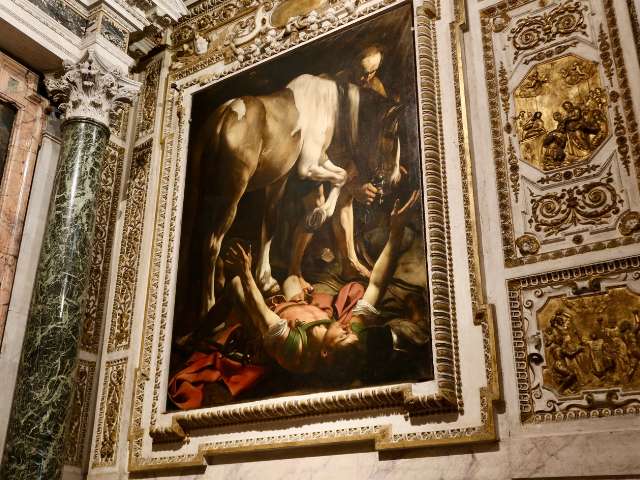 The way Caravaggio painted the light in this painting demonstrates his absolute mastery of the chiaroscuro technique
The way Caravaggio painted the light in this painting demonstrates his absolute mastery of the chiaroscuro techniqueAn interesting detail in the painting is that Caravaggio has Saint Paul falling from a horse.
The painting therefore started a myth that Saul was on horseback, yet the text in the Bible does not mention this.
The use of light in his typical style makes this stand out as one of Caravaggio's most impressive works.
The central painting in the Cerasi chapel is by a different artist, Annibale Caracci.
His style was far more traditional, with his painting 'The Assumption of Mary' fitting in with other more Renaissance-style works featuring bright colors and uniformly beautiful people.
The story goes that Caravaggio deliberately painted the back end of the horse in his depiction of St Paul's conversion to be facing Caracci's piece as a way to indicate his poor opinion of Carraci.
As entertaining as this sounds, there is no evidence that Caravaggio was this petty!
San Luigi dei Francesi (between Piazza Navona and the Pantheon)
The church of San Luigi dei Francesi, just to the east of Piazza Navona, is the home of the world-famous three painting cycle that Caravaggio painted about the life of Saint Matthew.
All three Caravaggio's paintings of Saint Matthew are in the Contarelli Chapel.
The three Caravaggio paintings were his first major commission in Rome.
Calling of St Matthew, c. 1600, Contarelli Chapel
The Calling of St Matthew is on the left wall of the chapel inside the church of San Luigi dei Francesi.
The painting depicts the moment at which Jesus inspires St Matthew to follow him.
Martyrdom of St Matthew, 1600, Contarelli Chapel
The Martyrdom of St Matthew inside San Luigi Dei Francesi is on the central panel.
As with many Roman chapels, the Contarelli Chapel is not lit permanently, and yet Caravaggio uses his style of contrasting dark and light to bring it to life.
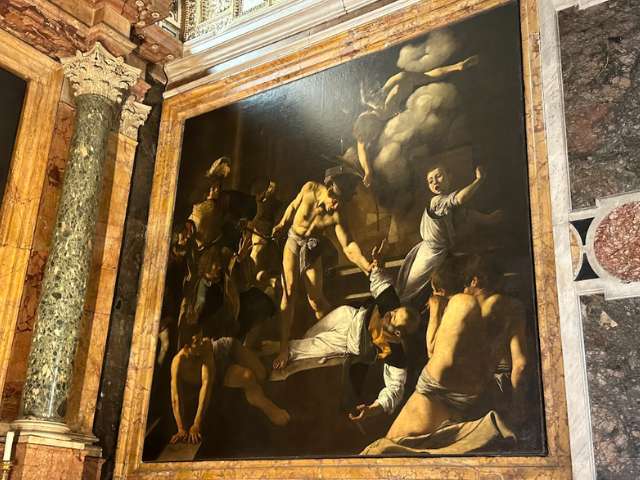 See the natural beam of light coming down in the picture? This was planned for when Caravaggio designed the chapel
See the natural beam of light coming down in the picture? This was planned for when Caravaggio designed the chapelNotably, the two side panels are lit by a solitary beam of light from the only source of natural light.
Caravaggio clearly considered this and painted his images accordingly.
Inspiration of St Matthew, 1692, Contarelli Chapel
The inspiration of St Matthew is on the right hand panel in the church of San Luigi.
In this painting, Saint Matthew sits at a desk as an angel stands before him to the right guiding his hands as Saint Matthew writes.
The life of Caravaggio
Want to learn more about Caravaggio's life and works?
This biography by art historian Andrew Graham-Dixon balances an in-depth account of Caravaggio's history along with reproductions of some of his most famous works.
Disclosure: If you make a purchase through a link on this page, I may receive a small commission - at no extra cost to you. Thank you for supporting my site!
Is Caravaggio's art Renaissance or Baroque?
Caravaggio is generally considered to be a Baroque artist rather than a Renaissance artist.
While he lived and worked during the late Renaissance period, his dramatic use of light and shadow, his naturalistic approach to depicting the human figure, and his emphasis on emotion and realism are all hallmarks of the Baroque style.
Caravaggio's work is often seen as a precursor to the Baroque period, which began shortly after his death.
Caravaggio was also known for his naturalistic approach to painting, with a focus on creating lifelike figures with dramatic lighting and realistic facial expressions.
His work often featured everyday people as his subjects, and he sought to convey their humanity and emotions in a direct and unvarnished way.
While Caravaggio's work was innovative and groundbreaking in its own right, it can be seen as a reaction against the exaggerated style of Mannerism that had dominated the preceding period.
The perfect 3-day itinerary in Rome
Trying to figure out how to organize your visit to Rome? I've got the perfect 3-day itinerary for first-time visitors (or those who have not been here in a while.) It works for a 2.5 day visit as well.
In my 3-day itinerary, you'll see all the major must-see Rome attractions like the Vatican, Colosseum, Trevi Fountain, Pantheon, Piazza Navona, Spanish Steps, and much more.
And if you have more time, or want suggestions for extra/other things to do, you'll find that there too.
Visit my page with the best 3-day itinerary in Rome for first-timers.
Where else can you see Caravaggio paintings in Italy?
You can see more masterpieces by Caravaggio in Naples and Florence, each about an hour from Rome.
Caravaggio in Naples
Plenty of Caravaggio's life was spent in Naples, and there is a Caravaggio painting on display at the Palazzo Zevallos Stigliano.
The Martyrdom of Saint Ursula, 1610, Palazzo Zevallos Stigliano
The Martyrdom of Saint Ursuala was painted during Caravaggio's time in Naples and is widely believed to be his last work.
It was commissioned by Marcantonio Doria, an avid collector of Caravaggio.
The work depicts Saint Ursula after her companions had been brutally murdered by the king of the Huns who offered to spare her in return for her hand in marriage.
She refused and was punished as a result.
Caravaggio in Florence
While the artist did not spend much, if any, time in Florence, you can see many of his works here.
The two best places to see masterpieces by the artist are at the Uffizi Galleries and Pitti Palace.
A third location, the Fondazione Roberto Longhi, is out of the city center but also visitable, so if you're visiting Florence, you will not miss out on seeing some Caravaggio!
Romewise's Top Travel Resources
Ready to book your trip to Rome? Take a look at these helpful links to companies we use and trust:
- Keep your travel spending simple with the Wise card, which removes all the worry about exchange rates and high transaction fees all over the world
- Search for and book your perfect accommodation
- Our complete guide to what to pack for Rome
- The number one travel accessory, a multi-point travel adapter and voltage converter
- Browse a huge range of tours in Rome and beyond
- Experience unique tours and special access to Rome's most popular sights
- Protect yourself with comprehensive travel insurance
Within this post there are some affiliate links for products and services. For more details about our affiliate policy click here.
Get your 100% free Rome trip planner now!
Simply sign-up today for our free newsletter and get the Romewise Quick Start guide to Rome:
We are committed to respecting your data. Click for our Privacy Policy.
Comments? Questions? Suggestions?
Please come over to the private Romewise Facebook group and join in the conversation.
You will often find me there, happy to answer your questions / comments!
You will also meet other Rome lovers and experts, too.
What are you waiting for?
- Romewise Home Page
- What to Do in Rome
- caravaggio paintings in rome

